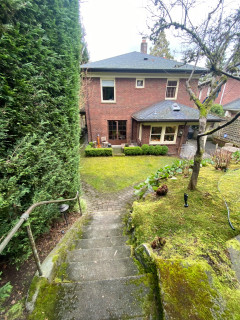
This article was originally published by a www.houzz.com . Read the Original article here. .
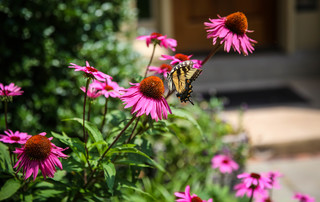
4. Pollinators Need More Than Just Flowers
Without foliage to eat, many youngsters and future butterflies, moths, flies and beetles would starve. The same can be said about pollen, which a lot of native bee species use to feed their young. Shallow flowers like asters (Symphyotrichum spp., zones 3 to 8, depending on sepcies) and sunflowers (Helianthus annuus, zones 2 to 11, depending on species) tend to attract a greater diversity of adult pollinators, but that doesn’t mean you should stick to that one form.
Additionally, try to use straight species where you can. These are native plants that have not been crossed or bred with others to produce new leaf colors or new flower colors and shapes. When plants are altered, the chemical makeup of their leaves may change and be unable to support as many caterpillars.
This article was originally published by a www.houzz.com . Read the Original article here. .
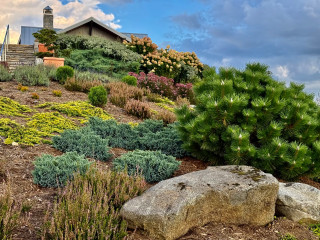
“The biggest challenge was balance. I didn’t want the garden to compete with the mountains. But the garden needed to speak to the mountains and hold its own against them without overpowering them,” Sifford says. The tectonic plates that formed the mountains hundreds of millions of years ago inspired his design, which is composed of stunning mounds of plants, including grasses, shrubs, ground covers, evergreens and perennials.
This article was originally published by a www.houzz.com . Read the Original article here. .
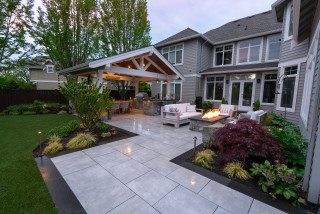
Przygoda-Montgomery, who designed the shaded patio in Oro Valley, Arizona, seen here, says that a way to assess whether your yard is guest-ready is to actually host something. “If people are left standing awkwardly or are unsure where to gather, it’s a sign that the space needs better flow and a better furniture arrangement,” she says.
How to Create an Inviting Outdoor Seating Area
This article was originally published by a www.houzz.com . Read the Original article here. .
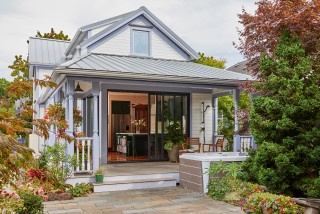
One of the homeowners loves to cook and bake. The other’s interest in the culinary arts lies primarily in enjoying food. “The cook had a lot of specialty tools and gadgets he wanted to use,” Rachaman says. “He cooks Asian food a lot and wanted specific places to put things like the small bowls he likes to serve it in.” The designers planned storage to house items like this, as well as spices, mixing bowls, baking sheets and cutting boards. The homeowner also has a large cookbook collection, and the designers tailored the island to house them.
One quirky part of the renovation involved one of the homeowners’ cold morning swims in Lake Washington. “He hangs his wetsuit to dry in the coat closet,” Emhoff says. “He wanted the fridge to back up to this closet so the heat coming off it would help dry the wetsuit.” There’s a vented wall between the back of the fridge and the coat closet.
Cabinetry: Bellmont Cabinet; cabinet paint: Olympic Range, Sherwin-Williams; wall paint: Pink Ground, Farrow & Ball
Browse kitchen and dining furniture in the Houzz Shop
This article was originally published by a www.houzz.com . Read the Original article here. .

Automate as many maintenance chores as you can. A good place to start is with your irrigation systems. You can add timers to in-ground systems, drip systems and soaker hoses. These systems allow for watering all parts of a garden without having to drag a hose from place to place. In-ground systems with a timer also reduce the possibility of tripping over a garden hose. You can set the timers for the times that are best for both you and your garden, such as during the night.
Take it a step further by adding other automated features, such as motion-activated lights that come on when you step out at night or lights that turn on and off on a regular schedule.
New smart and automated garden products and features are rapidly coming on the market as well. Look through gardening magazines and websites, and talk to the staff at nurseries and hardware stores about what automated features they would recommend.
Bonus: An automated watering system, particularly one with smart features, ensures that your garden will get the water it needs when it needs it, and often results in using less water.
Plus, automating both your irrigation and your lighting will allow you to go on vacation without scouring the neighborhood for someone to tend to your plants or, if it’s in a front yard, worrying that your home will look empty.
This article was originally published by a www.houzz.com . Read the Original article here. .

If you live in an area with a warm-winter climate, you might want to consider a tile path.
Tiles can be less expensive than concrete, stone and brick while still delivering plenty of style. Options include terra-cotta and clay tiles as well as unglazed ceramic and porcelain tiles.
Glazed terra-cotta or clay tiles, with their rustic appeal, earth tones and natural variations, are a great choice for paths in the Southwest, but they also can feel at home in other warm-climate areas. These tiles can take day-to-day wear; between the two, terra-cotta tiles are less prone to cracking. You can set either on a concrete or sand-and-gravel base, although the former will provide more stability. Clay tile can be more slippery than terra-cotta tile when wet.
The porous nature of terra-cotta and clay tiles makes them more susceptible to stains, fading and surface damage. To keep them looking their best, clean up dirt and debris regularly and address any stains as soon as they appear. Applying a sealant can help protect against discoloration and wear, but keep in mind that resealing every few years would be necessary to maintain that protection.
This article was originally published by a www.houzz.com . Read the Original article here. .

If you live in an area with a warm-winter climate, you might want to consider a tile path.
Tiles can be less expensive than concrete, stone and brick while still delivering plenty of style. Options include terra-cotta and clay tiles as well as unglazed ceramic and porcelain tiles.
Glazed terra-cotta or clay tiles, with their rustic appeal, earth tones and natural variations, are a great choice for paths in the Southwest, but they also can feel at home in other warm-climate areas. These tiles can take day-to-day wear; between the two, terra-cotta tiles are less prone to cracking. You can set either on a concrete or sand-and-gravel base, although the former will provide more stability. Clay tile can be more slippery than terra-cotta tile when wet.
The porous nature of terra-cotta and clay tiles makes them more susceptible to stains, fading and surface damage. To keep them looking their best, clean up dirt and debris regularly and address any stains as soon as they appear. Applying a sealant can help protect against discoloration and wear, but keep in mind that resealing every few years would be necessary to maintain that protection.
This article was originally published by a www.houzz.com . Read the Original article here. .

Bringing some of the health benefits of the wilderness to busy urban lives was another trend seen across the show. The most striking example of this was the Fettercairn Wilderness Retreat balcony garden (pictured) by ssh scapes — Sonia Kamel, Sally Giles and Helier Bowling — and inspired by the wild landscape of the Scottish Cairngorms mountains.
This small urban space was designed for a busy professional couple “who love the outdoors and, in particular, the Cairngorms in Scotland, and want to recreate the environment for daily health benefits on their high-rise city balcony,” according to the RHS.
At the heart of the space was a copper bath perfect for a cold-water dip, which was surrounded by wild planting reminiscent of the grassy heaths, rocky outcrops and mossy glens typical of the area.
Shop for outdoor products
This article was originally published by a www.houzz.com . Read the Original article here. .

As you plan your memorial garden, it’s important to think about the person your loved one was — “their quirks, their favorite things, their hobbies, their funny and inside jokes, their favorite words or sayings, their pets,” says Kristin Taunton, who worked with a design team on a memorial garden seen below. These personal touches can help shape a space that not only honors the person’s memory but also brings comfort and a lasting sense of connection.
This article was originally published by a www.houzz.com . Read the Original article here. .
The vine growing up the corner of the house and along the entry overhang was another priority within the design. “This is a hop vine [Humulus lupulus, zones 4 to 8] that the homeowner has been growing for many years. He had trained it across the overhang, and it was important to him that we protect it,” Galante says.
Galante reports that the homeowners love their pots and planters. She filled the built-in brick planters around the patio with ‘EverColor Everest’ Japanese sedge (Carex oshimensis EverColor Everest ’Carfit01’, zones 5 to 9), which adds soft color and texture against the fence. The pot on the right has autumn fern (Dryopteris erythrosora, zones 5 to 8) and creeping jenny (Lysimachia nummularia, zones 3 to 9).